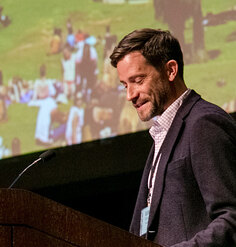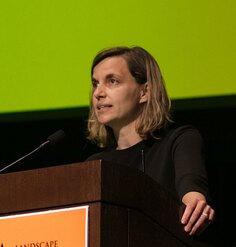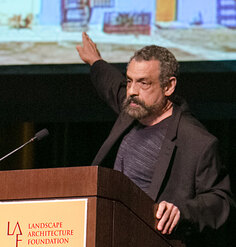Developing Landscapes of Resource Management
By Alpa Nawre
This presentation was part of the Landscape Architecture Foundation’s The New Landscape Declaration: A Summit on Landscape Architecture and the Future held in Philadelphia on June 10-11, 2016. LAF asked a diverse group of leading minds to write a “Declaration” reflecting on the last half century and offering bold ideas for how landscape architecture can make its vital contribution in response to the challenges of our time.
Alpa Nawre
Assistant Professor, Landscape Architecture and Regional & Community Planning, Kansas State University
Partner, Alpa Nawre Design
Manhattan, Kansas
Alpa Nawre is assistant professor in the Department of Landscape Architecture and Regional and Community Planning at Kansas State University and partner at her design practice, Alpa Nawre Design. Nawre holds a master of urban design from Harvard Graduate School of Design, a master of landscape architecture from Louisiana State University, and a bachelor of architecture from NIT, Raipur, India.
*Affiliation at the time of the Summit
Developing Landscapes of Resource Management
By Alpa Nawre
With what are we welcoming our future generations? Piles of plastic? Polluted air and dirty water? Life in degraded environments with mismanaged resources is the normal human experience in many parts of the world. The statistics are staggering. Of the total world population of 7.2 billion, about 6 billion people live in developing countries where access to clean water, clean air, and efficient systems of waste disposal is a daily struggle.
Water, especially, is a severely contested resource in these contexts, both in terms of quantity and quality. In India, for example, over 100 million people lack access to safe water, and diarrhea causes 1,600 deaths daily. Where water mafia and dacoits are a grim reality, where suicides, murders, and street fights over water scarcity are a serious issue, and where commuting to and from work could involve wading through chest- or knee-high floodwater, the problems associated with water management in India point to a crisis that is only expected to get worse with impending climate change impacts and rapid urbanization. And while some problems clearly fall outside the scope of a landscape architect, there are many issues that can be addressed through better water management landscapes. This is where the agency and action of landscape architects at both the systems and the site scales become critical, applicable not only to water but also to other contested resources.
Today, in developed countries we are shocked by and somewhat resigned to reports and personal experiences of Beijing’s air quality, the water crisis in India, or food scarcity in Africa. Conditions, however, were not so very different in the 1950s and 1960s in North America when people wore gas masks in Los Angeles and decried the region’s filthy rivers. When a small group of landscape architects gathered in Philadelphia and crafted the 1966 Declaration of Concern, noting the degradation of America’s water and air, the world was not such a different place. Now, however, the issues have become more global, critical, and widespread.
In this context of contested resources, landscape architects must step in to do what we can to restore and reestablish healthy relationships between humans and their environment. I entreat all landscape architects to rise above parochial discussions, territorial predispositions, and disciplinary comfort zones to address the very real issues of water, air, food, waste, minerals, and energy, with which rapidly urbanizing and developing countries such as India now grapple.
The 1966 Declaration of Concern is a demonstration of the enormous responsibilities that the profession attempted to take on. The last 50 years have seen the coming of age of the landscape architecture profession. We have drawn on formidable skills of research and analysis to understand and map multilayered issues, and we have conveyed this understanding to the general public through visualization of complex landscape systems spanning both scale and time. Many landscape architects have attempted to restore damaged ecosystems and design better human/nonhuman habitats. Yet, we have just scratched the surface, and much remains to be done in the context of resource management, especially that of water, food, and waste in developing countries.
From these countries, there are many lessons to be learned on alternative definitions, frames, paradigms, systems, and landscapes of resource management, all of which are rapidly being transformed and degraded as we speak. We urgently need to understand the various ecologies of resource management in the developing world. What can we learn from cultures that designed multifunctional resource infrastructure and practiced community ownership of landscapes to inform the design of resource management in industrially developed countries and vice versa? Before we engage in design, we must understand and evaluate existing systems.
As designers, we have two avenues of intervention for addressing resource issues. The first is through design to improve existing resource landscapes, and the second is to create alternative paradigms for better resource management through the structuring of new built environments. The projected increase of the world’s population to nine billion by 2050 will be almost entirely from developing countries, accompanied by rapid urbanization. For example, in the next 50 years, India’s population will peak at 1.6 billion and the country will be adding more than 400 million to its urban population—about 20 more Mumbais! The development of urban territories to accommodate these millions desperately needs the expertise of landscape architects equipped to design urban landscape systems for better resource management. It also presents unprecedented opportunities for design experimentation. How do we take the lessons we have learned in the urbanization of developed economies and apply them in our design responses to the resource management problems of the developing world?
Part of the challenge is not only to address resource management issues head-on but also to make the public—especially the decision makers in the developing world—aware of the contribution that we can make in improving resource management.
In most parts of India, when I introduce myself as a landscape architect, people either transform the phrase to landscaping or gardening or latch on to the familiar architecture—not surprising since there are very few landscape architects in India. About 800 landscape architects serve a total population of 1.25 billion, and of this handful, fewer still engage in issues of resource scarcity and/or mismanagement. As landscape architects, we must actively make opportunities for engagement happen by better preparing ourselves with alternative design solutions and communicating them to the public.
Today’s landscape architecture students live in a complex, networked world and must be prepared for a future defined by global professional practice, to meaningfully engage in and to craft the built environment of not only their own community but also of cultures dramatically different from their own—dealing with life-threatening issues related to water, food, and waste. These issues often fall outside a landscape architect’s traditional scope (a missed opportunity for the discipline). Training the future generation of landscape architects to deal with these issues at different scales is the only way to make our discipline relevant in the coming 50 years.
It is an exciting time to be a landscape architect, but only if we embrace the opportunities and challenges ahead of us. There must be a crusading determination on the part of landscape architects to address the real issues of resource management if we are ever to permanently establish and realize the true potential of our discipline.











